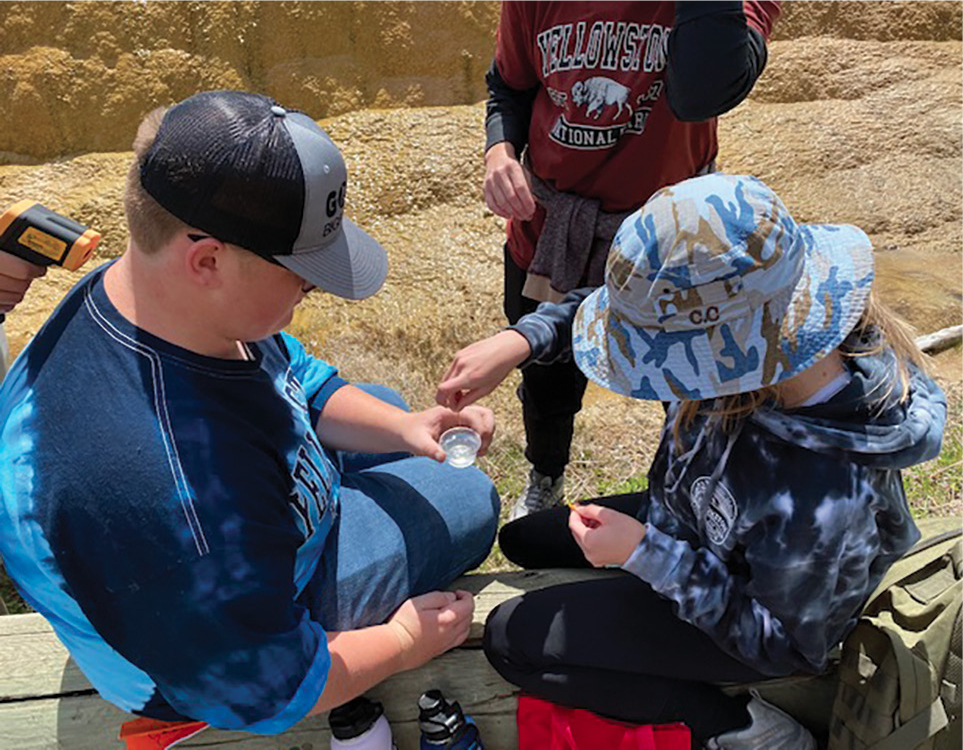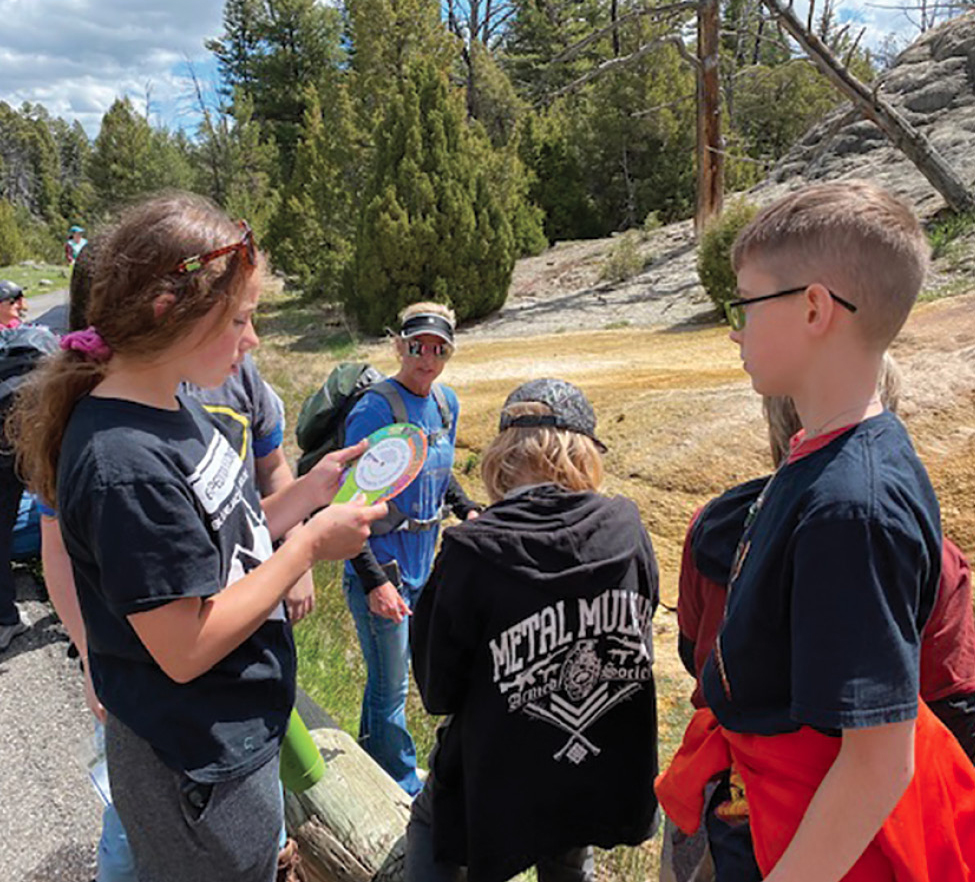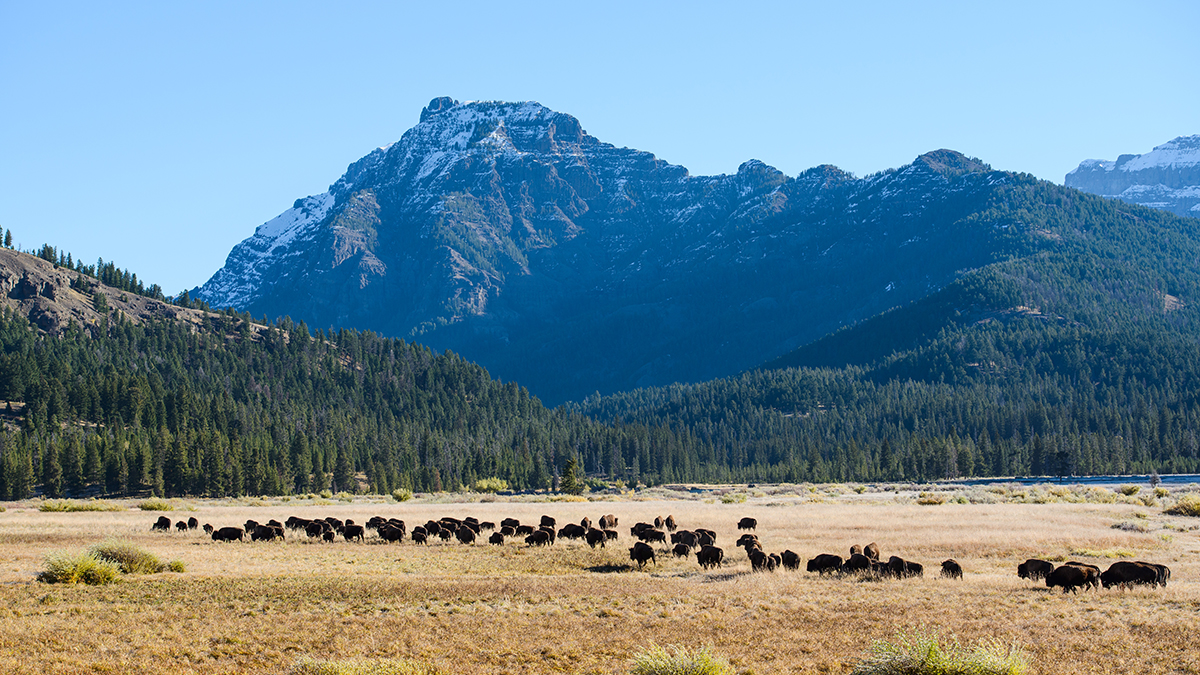feature
The Power of Shared Experiences
Going Outside the Classroom to Build a Classroom Community
Historically, teaching environments often position middle-level science learners within the four walls of a classroom, sitting at a desk and reading about lived experiences of scientists. To move students away from these traditional learning environments, the Next Generation Science Standards (NGSS; NGSS Lead States 2013) provide a framework to actively engage students in learning about science and scientific practices that parallel the work of science researchers. Leveraging the expectations of the NGSS, place-based education, sometimes called place-based learning, further removes students from typical classroom experiences and places them into the same environments where learning is taking place (Meichtry and Smith 2007). This geographic “sense of place” can be a schoolyard, neighborhood, town, or national park (McInerney, Smyth, and Down 2011). These special or unique places have been shown to strengthen students’ science content knowledge, feelings of connectedness to their teachers and peers, team-building skills, sense of authentic human attachment, and belonging to a place (Place-based Education Evaluation Collaborative 2010; Semken and Freeman 2008; Smith 2002; Van der Hoeven Kraft et al. 2011).
Merely telling students about nature’s interconnectedness cannot create the effect of their experiencing it. Try this: Stand in your classroom with your eyes closed and take 10 deep breaths. Now go outdoors and repeat the exercise. Moving outdoors to conduct this exercise heightens different senses and stimulates different ways of thinking about your surroundings. Imagine your entire class moving from a structured classroom environment to an outdoor learning environment. Students will take away different thoughts, ideas, and feelings about the same experience and also develop a sense of community through this experience. This article describes how the power of a shared experience in Yellowstone National Park created a very unique classroom community among 25 middle-level students from a small rural school in Bluejacket, Oklahoma, as they prepared for and participated in a place-based learning experience.
A science wonderland
Yellowstone National Park’s diverse natural phenomena are due in large part to the fact that it sits on top of an active supervolcano. With magma chambers shallowly located only a few miles below the caldera surface, superheated ground water makes its way to the surface via geysers, hot springs, fumaroles, and mudpots. Another phenomenon associated with Yellowstone’s geologic history includes mile-high glaciers that moved under their own weight and carved out “U” shaped valleys with rich glacial silt. These two natural phenomena (a supervolcano and glaciers) shape the ecology, geology, microbiology, and other scientific “ologies” resulting in a wide range of terrestrial and aquatic habitats—thereby making Yellowstone National Park the perfect place for children of all ages to explore. While Yellowstone’s phenomena can be used to address many NGSS and NGSS performance expectations, this particular article focuses on the standard MS-ESS2: Earth Systems and performance expectation MS-ESS2-2. Construct an explanation based on evidence for how geoscience processes have changed Earth’s surface at varying time and spatial scales.
With the goal of fostering future stewards of natural environments, Yellowstone National Park hosts the Expedition Yellowstone (EY) program (see the link to Expedition Yellowstone Program under Online Resources). This five-day curriculum-based residential program is designed for teachers and their fourth- to eighth-grade students to learn about nature. Mr. Shawn Martin, a middle school science teacher, applied to and was accepted into the EY program. Mr. Martin spent months preparing his students for the EY trip and focused on two types of team-building/community-strengthening/classroom management activities: fundraising and physical fitness training.
Fundraising
The EY program can be an expensive program to attend, so to ensure that personal finance was not an obstacle for any eligible middle-level student in his school wanting to attend the EY program, Mr. Martin identified potential community groups and organizations that might be interested in financially supporting this place-based learning experience. In teams, students made presentations to the various groups explaining why they wanted to attend the EY program and how they might benefit from such an experience. Because of the school district’s high Native American population, students also made a presentation to the Intertribal Council. Word of students’ efforts to raise money was reported by local newspapers, which resulted in enough money being raised to attend the EY program. Additional donors provided the group with matching shirts and hoodies, backpacks, socks, gloves, and food. One donor even provided hotel rooms for their two-day drive to and from Yellowstone (see Expedition Yellowstone Travel Checklist in Supplemental Materials).
Physical fitness training
The average elevation at Yellowstone National Park is 8,000 feet above sea level, whereas the elevation at Bluejacket, Oklahoma is 780 feet. Although little could be done to prepare for the extreme elevation change this group was about to experience, Mr. Martin organized Saturday morning “hiking trips” around his small rural town; parents and other community members even participated in the hikes. These practice hikes turned out to be more about team building, feeling connected to one another, and establishing a “classroom” management plan for the trip than actual fitness training (Wenger 2011). Students did practice how to walk in an organized fashion and talk in a low voice, all while meeting the other students they would be traveling with. These training sessions also garnished the attention of the state’s TV news station; reporters for the station attended some of the hikes and even interviewed students.
Although students and chaperones were prepared and ready to embark on their EY adventure in April 2020, the COVID pandemic struck and their place-based learning adventure was postponed until September. Unfortunately, the pandemic continued, and their trip was cancelled for a second time. Because the EY program is age specific, many students were afraid that they would age out before the EY program became operational again. This series of events strengthened the Bluejacket community as they all worked together to make this trip a possibility for their students. So, when COVID vaccinations became available and travel bans were lifted, the Bluejacket school board invited me to serve as their group’s Yellowstone education field guide. Because I frequent Yellowstone, teach a Yellowstone Science for Educators college course, and even conducted my sabbatical in Yellowstone with the EY program, I felt qualified to lead the group. While I could not mirror the EY education program, I could provide Team Bluejacket with their own personal Yellowstone place-based learning experience. Because we were not participating in the EY program, we did not stay in the designated EY Buffalo Ranch cabins. Instead, we stayed at the Yellowstone Studies Center located in the small town of West Yellowstone. The facility provides education groups with sleeping quarters with cots, a kitchen, bathroom facilities, and several recreation rooms at a reduced rate compared to hotel rates.
Keeping a nature journal
We all see the world through our own personal lens, one that is shaped by both our experiences and our goals. Research has suggested that when we write about something, we tend to observe it in more detail, making it easier for us to remember (Tsevreni 2020). Thus, a nature journal was designed to complement each day’s adventures (see Yellowstone Nature Journal in Supplemental Materials). In addition to writing reflections throughout the day, at the end of each day, students were also asked to reflect on the day’s experiences with the following writing prompts: What was the most exciting thing you saw or did today? Describe how it made you feel.
Day 1
As the itinerary reveals, we visited multiple places each day (see Yellowstone Place-Based Travel Itinerary in Supplemental Materials); however, this article highlights only some of the science learning adventures. Because team Bluejacket entered Yellowstone from the south entrance, our first stop was to the Upper Geyser Basin, which contains the largest concentration of hot springs in the world, and we arrived just in time to see the eruption of Old Faithful Geyser. For their first reflective writing exercise, students were asked to reflect on what they heard, saw, and felt when the geyser erupted. They were also asked to draw a picture of Old Faithful before and during the eruption. Our experience of the world is deeply subjective, so to provide more venues for self-reflection, the nature journal often tasked students to reflect by using the written word and personal drawings.
Day 2
Yellowstone’s Lamar Valley is a “U” shaped glacial-carved valley that is home to many species of large mammals such as the bison, elk, wolf, grizzly bear, and black bear. The Trout Lake trail is a short 1.2-mile lollypop loop trail that takes hikers through a forest of Douglas firs before opening up to a deep beautiful lake surrounded by mountains. Students (with an adult chaperone) were tasked to walk around the lake in groups of three to four, find the spot that the group agreed had the most beautiful view, draw a picture, and describe characteristics that made their spot special. As humans, we are incapable of experiencing the same patch of earth in the same way, thus this nature activity encouraged students to listen to the views and opinions of others and achieve consensus.
Day 3
We traveled to the east side of Yellowstone’s lower loop to visit the Grand Canyon of the Yellowstone Lower Falls. This deep “V” shaped canyon continues to be sculpted as high volumes of water travel over the soft, hydrothermally altered rock. After walking down the 0.7-mile switchback trail, we stood at the brink of the canyon’s lower falls. This is where we did a math activity to determine how much water flows over the falls each minute, each hour, and each day if 63,500 gallons of water flows over the brink of the Lower Falls each second.
To help students make sense of Yellowstone’s natural phenomena, during our visits to places like the Petrified Tree, Sheepeater Cliff, and Artist Paint Pots, students were asked to reflect on how these phenomena came to be. For example, students were asked to provide a possible explanation for how the very large glacial erratics, found in Lamar Valley, ended up in a valley. Students suggested that because the rocks did not appear to come from the surrounding mountains, they must have come from “a long way away” and that the only explanation could be that they came from a “volcano erupting and spitting the rocks out into the air and landing in Lamar Valley” or that they “rolled down from some place else.” As the discussion continued, they decided that the rocks must have “rolled in” because they were smoother than the volcanic rocks they saw the day before. Our group discussion ended with the term erratics, which means to wander. As a melting glacier moves, it loosens attached mountain rocks, causing them to move under the force of the gliding glacier. Scientists can study ice flow routes by tracing erratics back to their parent bedrock.
Day 4
We spent much of the day in the Mammoth Hot Springs area collecting data from two hot springs. I had obtained an education research permit in advance of our trip to Yellowstone. Students recorded the colors of the thermophiles living in the water, collected water samples, used litmus paper to identify the water’s pH (see Figure 1), and used digital temperature guns to determine the water’s temperature (see Figure 2). Using a microorganism wheel and the data they collected, team consensus had to be achieved as to which thermophile(s) were likely living in each hot spring (see Figure 3). Students recorded all data in their nature journals.

Students learn to use litmus paper to determine the pH of Orange Spring Mound’s water. This hot spring is located at Mammoth Hot Spring’s upper terrace.

Careful to protect and preserve the integrity of Orange Spring Mound hot spring, a student uses a digital temperature gun to determine the water’s temperature.

Students use the data they collected (water pH, temperature, and color) and the Microbe Identification Guide to determine which thermophile(s) could possibly be inhabiting the hot spring.
Day 5
Before leaving Yellowstone, we hiked up to the Grand Prismatic Overlook. Using information learned over the previous four days, students were able to explain that the bands of color are mats of thermophiles and that each species of thermophile thrives in water with a specific pH and temperature range—music to this science teacher’s ears!
Finding local resources
While Yellowstone National Park is the pinnacle of parks (in my opinion), your state has its own national, state, or local parks that are unique to the area. Providing students with an opportunity to get outside and explore can be the educational experience that sparks students’ interest in learning about science. If you cannot take your students to Yellowstone but would like them to experience Yellowstone’s science vicariously, I encourage you to incorporate two 5E lessons in to your curriculum. Both articles were published in Science Scope: “Cougars, and bears, and wolves, oh elk!: Natural Ecological Patterns in Yellowstone National Park” (Angle and Taylor 2019) and “Some Like it Hot: Extremophiles in Yellowstone National Park” (Angle and Jones 2021).
Safety
Yellowstone National Park is home to both grizzly and black bears so adult chaperones carried bear spray on all outdoor learning adventures. Additionally, students were not allowed to wander outside on their own without adult supervision. To maximize the enjoyment of—and learning opportunities for—all 25 of these middle school students, their individual needs were taken into consideration. Students received a detailed itinerary for each day, and if a student felt that they were unable to participate in a specific event—such as walking down to the lower falls of the Grand Canyon of the Yellowstone—one or more chaperones stayed with that student until the group returned.
Conclusion
Making sense of the world is a fundamental goal of science and was the core of what occurred during our Yellowstone education adventure. Students worked together to share ideas, evaluated competing ideas, critiqued one another’s ideas, and developed a positive learning community (Schwarz, Passmore, and Reiser 2016; see a student’s reflective comment in Figure 4). While nature provides us with interesting experiences, the power of these shared experiences cultivates a sense of togetherness and ultimately a classroom community. •

Example of a Bluejacket student’s reflective writings on their place-based learning experience.
Acknowledgments
I would like to thank Mr. Shawn Martin, and the students, adult chaperones, and community of Bluejacket, Oklahoma for allowing me to serve as their Yellowstone education field guide. I could not have asked for a better group of individuals to spend time with in my favorite place on Earth—Yellowstone National Park. You can follow our Yellowstone adventure on my Discover Yellowstone Facebook site.
Online Resources
Expedition Yellowstone Program—https://www.nps.gov/yell/planyourvisit/expeditionyell.htm
Supplemental Materials
Yellowstone Place-Based Travel Itinerary—https://bit.ly/3fWP17U
Yellowstone Nature Journal—https://bit.ly/3Gad3ao
Expedition Yellowstone Travel Checklist—https://bit.ly/3r4BYrC
Julie Angle (julie.angle@okstate.edu) is an Associate Professor in Science Education at Oklahoma State University in Stillwater, Oklahoma.
5E Biology Chemistry Environmental Science Inquiry Instructional Materials Teaching Strategies Middle School



